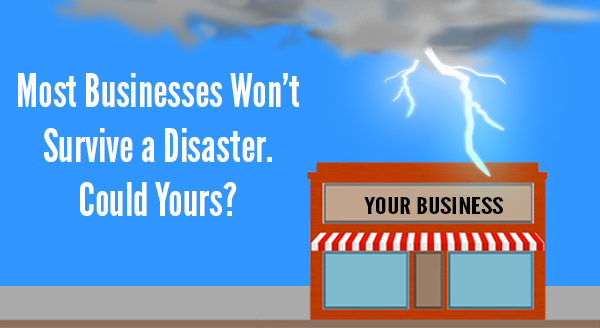
With human errors, natural disasters, power problems and cyber terrorism on the rise, it’s not a case of ‘if’ a disaster will strike your business, but ‘when’ will it happen. If it does happen it is usually not the scope and size of the event that influences how your business is impacted but whether a business has a plan to work their way through the issues.
Put simply, this is a business continuity plan – a document that lays out the pre-planned responses to an event, laid out in detail and implemented to keep your business running with little or no downtime. Think about what would happen if your business was hit by a disaster tomorrow. Would it survive and how much downtime would it take to push you into dangerous territory?
According to an IBM study of companies that have had a major loss of data, 43% never reopen, 51% close within two years and just 6% will survive long-term. For some of those survivors their business continued as usual thanks to their business continuity plan. It is more than just disaster recovery, it’s full preparedness that bypasses the need for weeks of downtime, financial ruin, wasted salaries and a loss of reputation – but it does require a level of advanced planning.
Recommendations
Here are some recommendations on how to help your business survive a disaster.
Prioritize: You will need to plan exactly what you’ll recover first and know who is in charge of making that happen. It goes beyond a checklist of things to do, it is taking an analytical, process-based approach to recovery for each unique business perspective. But be realistic and plan to adapt – there is no point using precious time to reviving the email system if your financial data is leaking onto the internet – even if email did rank as your top priority!
Backup: The most critical part of your business continuity is having full backups located in three places. Why three? One copy locally which you rotate offsite each day, a backup offsite and one in the cloud. The local and offsite backups come into play for system crashes, cyber-attacks and the like. While the cloud backup comes into play when your business has taken a major physical hit, perhaps from fire, flood or other natural disaster where your location is not accessible or destroyed. Some businesses can run entirely location-independent when using cloud systems like Office365, which can be enough to help them survive.
Test: Make sure all employees know what the plan is, where it is located and their role in the plan. It is also recommended to test, prepare and rehearse your continuity plan under simulated disaster conditions. This will uncover new obstacles, priorities, additional threats and other potential problems before it is too late.
As businesses IT environments becomes more and more complex the importance of a robust business continuity plan increases. The best plans look beyond disaster recovery, taking into account scalability of your system and scope of your individual business, to help create strong battle lines that will keep your business operational, both now and in the long term.
Give us a call at 08 8326 4364 to discuss your requirements and assist you in creating a custom business continuity plan for your business.
